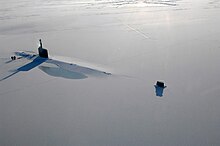USS Annapolis (SSN-760)
 The Annapolis in 2005 when equipped in Manama, Bahrain |
|
| Overview | |
|---|---|
| Order | March 21, 1986 |
| Keel laying | June 15, 1988 |
| Launch | May 18, 1991 |
| 1. Period of service |
|
| Commissioning | April 11, 1992 |
| Technical specifications | |
| displacement |
6300 tons surfaced, 7100 tons submerged |
| length |
110.3 m |
| width |
10 m |
| Draft |
9.7 m |
| Diving depth | approx. 300 m |
| crew |
12 officers, 115 men |
| drive |
An S6G reactor |
| speed |
30+ knots |
| Armament |
4 533 mm torpedo tubes , 12 VLS tubes |
The USS Annapolis (SSN-760) is a nuclear-powered submarine of the United States Navy and is part of the Los Angeles-class submarine to. It was named after the city of Annapolis , Maryland , where the United States Naval Academy is located.
history
The contract for the submarine was awarded to Electric Boat in 1986 . The keel was laid there in June 1988, and construction took almost three years. After the launch on May 18, 1991, the final equipment at the pier and test drives followed, on April 11, 1992 the Annapolis was officially put into service.
The first mission to the North Atlantic began at the end of 1993. A year later began a six-month transfer with USS Dwight D. Eisenhower (CVN-69) in the Mediterranean, which earned the submarine the Naval Expeditionary Medal and the Meritorious Unit Commendation . 1997/1998 the Annapolis sailed as part of the combat group around the USS George Washington (CVN-73) in the Persian Gulf , where it supported Operation Southern Watch and also fired BGM-109 Tomahawk at targets in Iraq.
In 2003 the submarine docked at the Portsmouth Naval Shipyard for an overhaul. Another voyage to the Persian Gulf followed in 2005, then to the Mediterranean in 2006, where the Annapolis entered Crete's port, among other places . In 2007 the submarine was involved in the Africa Partnership Station with the HSV-2 Swift , a mission in which numerous African navies are involved. In 2009 Annapolis took part in the ICEX exercise under the Arctic polar cap. On March 24, the submarine emerged through the one meter thick Arctic ice sheet.
Intelligence activity
The USS Annapolis is part of Submarine Development Squadron 12 , which equips and tests submarines with special capabilities for special forces and intelligence activities. In 2005 it was the first submarine to be equipped with RADIANT GEMSTONE technology and thus integrated into a new national communication network. According to media reports, it includes satellites and drones and can exchange data worldwide in real time. Further programs from the RADIANT series were added, in which monitoring and communication technology was used specifically for maritime use.
Since 2014 the USS Annapolis has been considered the lead ship in the test unit. Your new BLINDDATE system was tested on a mission through the Mediterranean Sea and unspecified waters of the Middle East and the ship was subsequently awarded. It is believed that the system will incorporate new capabilities, submerged and purely passive, to capture signal intelligence data. The revelations about the USS Annapolis' intelligence role stem from National Security Agency documents published by Edward Snowden .
literature
- Samuel Eliot Morison: The Two-Ocean War: A Short History of the United States Navy in the Second World War . Naval Institute Press, 2007 (English).
Web links
- Entry in Naval Vessel Register (Engl.)
- Homepage of Annapolis (Engl.)
Individual evidence
- ^ A b Adam Weinstein, William M. Arkin: Spying on the US Submarine That Spies For the NSA and CIA . On: Phase Zero / Gawker, April 7, 2015
- ↑ Global Security Archive: Intelligence Programs and Systems
